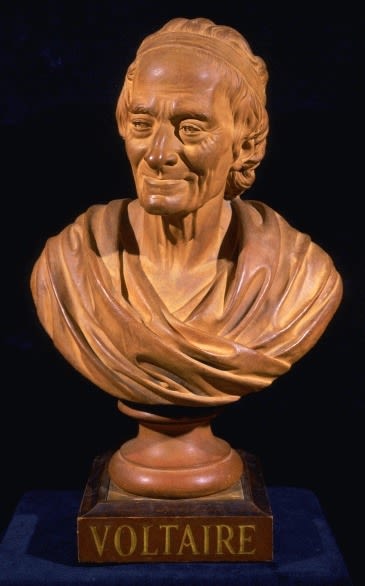
Nineteenth Century Continental School, after Houdon
To view all current artworks for sale visit philipmould.com
This bust skilfully captures the incisive wit and perception that to successive generations have become famous as the defining features of Voltaire's intelligence. It is based on a type executed by the celebrated French sculptor Jean-Antoine Houdon, a marble example of which is in the collection of the Hermitage, St Petersburg. The drapery suggesting a Greek cloak and the fillet bound about the temples conform to late eighteenth -and, indeed, subsequent- conceptions of how a latter-day cynic philosopher should be portrayed in art. Houdon's genius in distilling the essence of the principal figures of his day is reflected in the fact that his images of men such as Washington and Jefferson have become some of their most enduring icons.
Voltaire was born in Paris in 1694. He left school at 16 and soon formed friendships with a group of sophisticated Parisian aristocrats. Paris society sought his company for his cleverness, humour and remarkable talent for versifying. In 1717 he was arrested for writing a series of satirical verses ridiculing the French government, and was imprisoned in the Bastille. During his eleven months in prison he wrote his first major play, Oedipe, which achieved great success in 1718. He adopted his pen name of Voltaire the same year.
In 1726 Voltaire insulted a powerful young nobleman and was given two options: imprisonment or exile. He chose exile and from 1726 to 1729 lived in England. While in England Voltaire was attracted to the philosophy of John Locke and ideas of the great scientist Sir Isaac Newton. After his return to Paris he wrote a book praising English customs and institutions. The book was thought to criticize the French government and Voltaire was forced to flee Paris again.
In 1759 Voltaire purchased an estate called Ferney near the French-Swiss border where he lived until just before of his death. Ferney soon became the intellectual capitol of Europe. Throughout his years in exile Voltaire produced a constant flow of books, plays, pamphlets, and letters. He was a voice of reason, and an outspoken critic of religious intolerance and persecution.
Voltaire returned to a hero's welcome in Paris at the age eight three. He saw through the shallowness of popular plaudits, however, and remarked simply that an equal number of people would turn out with the same enthusiasm to see him hanged. The excitement of the trip was too much for him and he died in Paris. Because of his criticism of the church Voltaire was denied burial in church ground. He was finally buried at an abbey in Champagne. In 1791 his remains were moved to the Pantheon in Paris.
Be the first to hear about our available artworks
* denotes required fields
We will process the personal data you have supplied in accordance with our privacy policy (available on request). You can unsubscribe or change your preferences at any time by clicking the link in our emails.